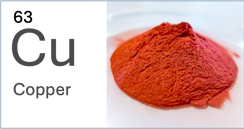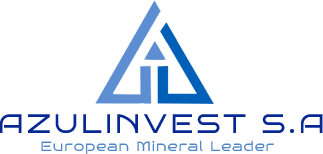TECHNOLOGY METALS

DESCRIPTION
A reddish or red-colored metal, Copper has exceptional electrical and thermal conductivity. The pure metal is very resistant to corrosion, but also very malleable Copper powder is very small in size, the deformation is followed as a function of the force applied. The average mass of a particle not exceeding 7 microns. Copper powder particles are spherical.
CHARACTERISTICS
Characteristics of ultrafine copper powder: 99.999% mass purity. by PMU isotope content – CU63-69.09%, CU65-30.91%, nowadays PMU ultrafine copper powder standard is widely used in various industrial fields: Nanotechnology, Microelectronics, Microbiology, Military industry, Friction components, Electrical contacts sintered permanent magnets, Chemical and nuclear industry, Catalyst, Metal injection molding (MIM), etc…
TECHNICAL DESCRIPTION
The sum of impurities in copper powder (Mg, Al, Ti, Fe, Ni, Zn, Mo, Cd, Sb) does not exceed 0.001% by weight. The purity grade of copper powder is 99.999% by weight. calculated on the difference between 100% and the sum of impurities. The list of impurities corresponds to TU 1793-011-50316079-2004.
The production volume of this type of product is constantly increasing every year, which is explained by the increase in demand.
The global Copper Powder market size was valued at USD 1286.94 million in 2022 and is expected to expand at a CAGR of 5.85% during the forecast period, reaching USD 1810.2 million by 2028.
Measured isotope Abundance % of Cu 63% 69.09±0.05
Measured isotope Abundance % of Cu65 % 30.91±0.03
PRODUCT TYPE
- Isotopic Ultrafine Copper Powder in Glass Jars
- Purity 99,999%
- Glass Jars of 200 grams each
- Weight Boxes, 40 Kilograms
- Sub-boxes, 40 Sub-boxes of 1 kg
- Five (5) Glass Jars per Sub-boxes
- Woods or Plastic Boxes
- Minimum Purchase Forty kilograms (40kg)
- Other, Standard request contact us.
- Isotopic Ultrafine Copper Powder in Pet Container
- Purity 99,999%
- Pet Container of 2 kilograms each
- Weight Boxes, 40 Kilograms
- Twenty (20( Pet Container of 2 Kg per box
- Aluminum or Plastic Boxes
- Minimum Purchase Forty kilograms (40kg)
- Other, Standard request contact us.
Our advisors, experts are constantly at your disposal in order to best understand the nature of your needs.
OUTLOOK AND SITUATION
The market value of Standard Ultrafine Copper Powder, 99.999%, represents approximately 2200 US Dollars per gram. Contact us to get the best prices depending on the quantity requested. To make one gram of this powder, more than a quarter of a ton of copper is required. However, the most expensive part of this process is the equipment needed to make it.
APPLICATION
Copper Powder is used in Nanotechnology, Microelectronics, Microbiology, Military industry, Chemical and nuclear industry, Electrical contacts sintered permanent magnets, Catalyst, Friction materials such as clutches and brakes, Diamond cutting tools, Lubricants, Friction components, Metal injection moulding (MIM) and much more..
SALES PROCEDURES
Our independence (Production) and our international raw material supply network, undoubtedly enable us to provide you with a safe and secure supply with all controls in terms of quality analysis, evaluation, inspections, import and export.
In order to guarantee a long-lasting and professional relationship with our customers, we have implemented a sales procedure allowing prior identification of our customers by opening customer accounts based on the provision of a Customer Buyer’s KYC Form Rare Minerals and Strategic Metals Account Opening, allowing us perfect identification from quotation requests made by consultants (intermediaries) and direct final buyer.
CATALOG MARKET PRICE
The composition of One (1) gram of Copper Powder is composed of two Isotopes Cu 63: 69.09% ±0.05, Cu65: 30.91% ±0.03, to calculate the value of one gram of Copper Powder please consult the International laboratory sites referenced below on the basis of one (1) gram of each isotope.
National Isotope Development Center (NIDC) is a International laboratory with a mission to support the U.S. Department of Energy’s Isotope Program.


